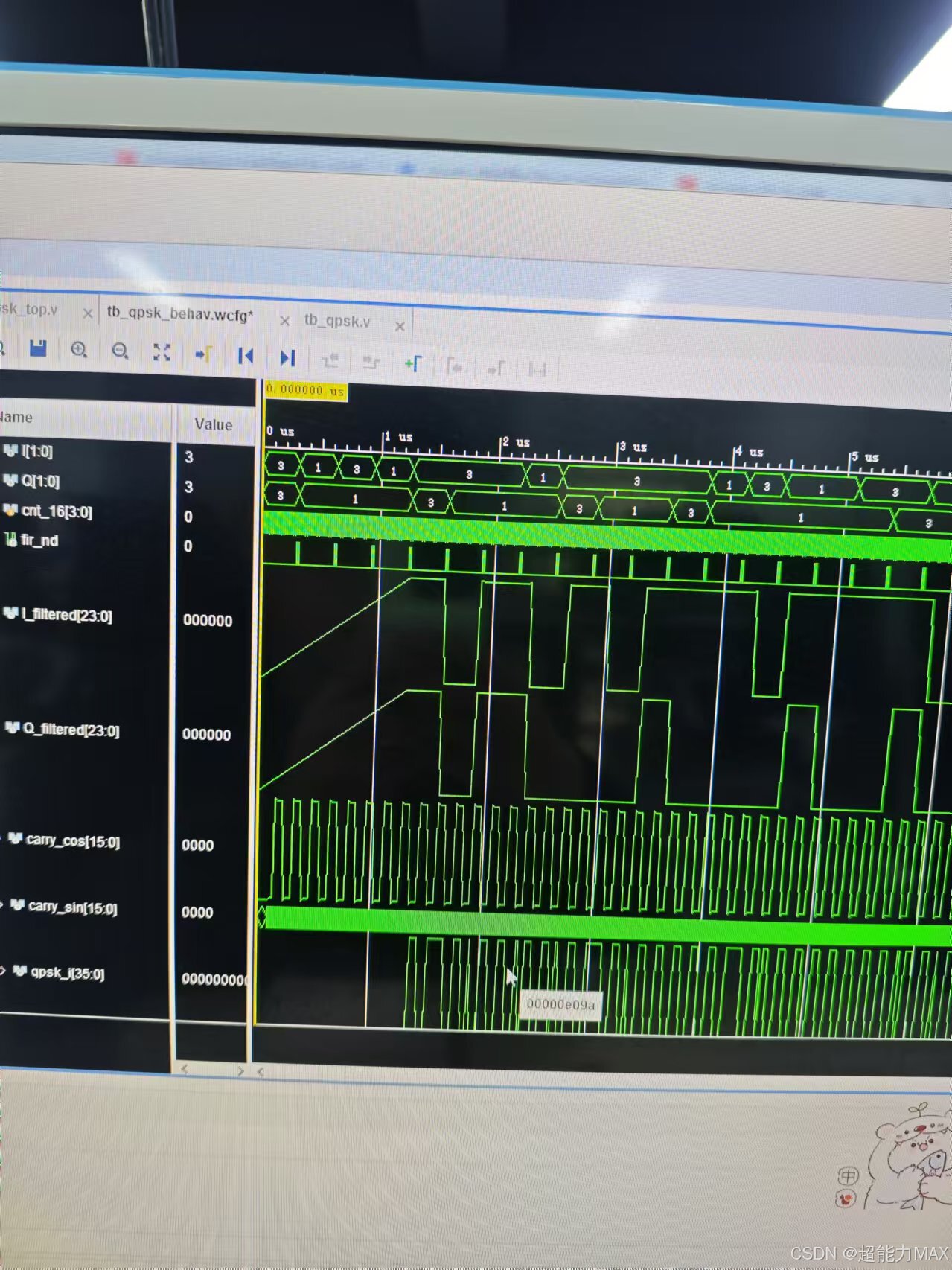借鉴该博文
matlab代码修改过后:
用matlab输入一组配置滤波器FIR IP核的系数:
% clc;
% clear;
% alpha = 0.15; % 滚降系数
% span = 6; % 表示截断的符号范围。
% inte = 16; % 内插系数
% % rcosdesign用于设计根升余弦滤波器的函数。
% hrc = rcosdesign(alpha, span, inte, 'sqrt');
% % 量化系数到16位整数
% hrc_q = fix(hrc./max(hrc)*(2^15-1)); % 量化系数16
%
% % 确保所有系数都是非负的,并且适合16位整数的范围
% hrc_q = max(hrc_q, 0);
% hrc_q = min(hrc_q, 2^15-1);
%
% % 打开文件
% file_path = "D:/L/vivado project/qpsk_sim/qpsk_sim.srcs/sources_1/ip/fir_hrc_16.coe";
% f = fopen(file_path, 'w');
% % 写入头信息
% fprintf(f, '; Example of a Distributed Arithmetic (DA) FIR Filter .COE file\n');
% fprintf(f, '; with hex coefficients, and 16-bit coefficients.\n');
% fprintf(f, 'Radix = 16;\n');
% fprintf(f, 'CoefData =\n');
% % 写入系数
% for i = 1:length(hrc_q)
% % 将整数转换为十六进制字符串,并去除前缀'0x'
% hex_str = dec2hex(hrc_q(i), 6); % 转换为6位十六进制数
% fprintf(f, '%s, ', hex_str);
% % 每8个系数换行,这是可选的,为了提高可读性
% if mod(i, 8) == 0
% fprintf(f, '\n');
% end
% end
% % 在文件末尾添加分号
% fprintf(f, ';\n');
% fclose(f);
再用matlab产生一组随机输入数据:
num_samples = 4096;
% 生成随机一位二进制数据
data_send_mem = randi([0 1], 1, num_samples);
% 将二进制数据写入文本文件
file_name = 'D:\L\vivado project\qpsk_sim\data_send_mem.txt';
file_id = fopen(file_name, 'w');
% 写入数据
for i = 1:num_samples
fprintf(file_id, '%d\n', data_send_mem(i));
% 每个比特后不加空格或换行,以生成连续的比特流
end
% 关闭文件
fclose(file_id);
disp(['Data has been written to ', file_name]);FIR\DDS\MUTIPILIER IP核配置参照上面链接
TB文件:
module qpsk_tb( );
//变量声明
reg clk;
reg rst;
wire [1:0]data_send;
wire [35:0] qpsk;
//例化BPSK生成模块
QPSK_top QPSK_top_inst(
.clk(clk),
.rst(rst),
.data_send(data_send[1:0]),
.qpsk( qpsk[35:0])
);
//激励时钟
always #10 clk = ~clk;
reg [0:0] data_send_mem[0:4095];
//初始化变量
initial
begin
clk <= 1'b0;
// rst <= 1'b1;
$readmemh("D:/ryno/ryno/VERILOG_BPSK/QPSK_PRO/data_send.txt",data_send_mem);
//读文件,读取文件中的输入符号至data_send_mem【“”中放你的提前生成好的随机数据路径】
// #20
rst <= 1'b0;
end
// //生成测试数据数据(随机产生的)
// always @(posedge clk)
// begin
// if (rst)
// begin
// data_send_m <= 1'b00;
// end
// else begin
// data_send_m<= $random();
// end
// end
//assign data_send = data_send_m;
reg [3:0] cnt_16 = 4'd0;
reg [10:0] cnt_mem = 11'd0;
always @ (posedge clk) begin
if(~rst) begin
cnt_16[3:0] <= cnt_16[3:0] + 4'd1; //在testbench中生成长度为16的计数器,控制输入数据的读取
end
end
always @ (posedge clk) begin
if(~rst) begin
if(cnt_16[3:0] == 4'd15) begin
cnt_mem[10:0] <= cnt_mem[10:0] + 11'd2; //地址,每16个时钟+2,取data_send_mem中的两个输入符号数据
end
end
end
assign data_send[1:0] = {data_send_mem[cnt_mem+1],data_send_mem[cnt_mem]}; //输入符号即为在存储器中取当前地址的数据
endmodule
top代码:
`timescale 1ns / 1ps
//
// Company:
// Engineer:
//
// Create Date: 2024/03/21 10:48:23
// Design Name:
// Module Name: QPSK_top
// Project Name:
// Target Devices:
// Tool Versions:
// Description:
//
// Dependencies:
//
// Revision:
// Revision 0.01 - File Created
// Additional Comments:
//
//
module QPSK_top(
input clk,
input rst,
input [1:0]data_send,
output [35:0] qpsk
);
wire [1:0]I;
wire [1:0]Q;
//对极化 :0——>+1(01) 1——>-1(11)
assign I ={data_send[0],1'b1};
assign Q ={data_send[1],1'b1};
reg [3:0] cnt_16 = 4'b00;//16计数器,内插系数是16(时钟速率是符号速率的4倍)
always @(posedge clk)
begin
if(rst) begin
cnt_16<=4'b00;
end else begin
cnt_16 <= cnt_16+1'b1;
end
end
wire fir_nd; //输入FIR滤波器有效信号
assign fir_nd = (cnt_16 == 4'd15);
wire [23:0] I_filtered;
wire [23:0] Q_filtered;
wire [15:0] carry_cos;
wire [15:0] carry_sin;
//I路成形滤波
rcosfilter rcosfilter_I (
.aclk(clk), // input wire aclk
.s_axis_data_tvalid(fir_nd), // 输入I路有效信号
.s_axis_data_tready(), // output wire s_axis_data_tready
.s_axis_data_tdata({6'd0,I[1:0]}), // input wire [7 : 0] s_axis_data_tdata {6{I[1]}}
.m_axis_data_tvalid(), // output wire m_axis_data_tvalid
.m_axis_data_tdata(I_filtered) // output wire [23 : 0] m_axis_data_tdata
);
//Q路成形滤波
rcosfilter rcosfilter_Q (
.aclk(clk), // input wire aclk
.s_axis_data_tvalid(fir_nd), // 输入Q路有效信号
.s_axis_data_tready(), // output wire s_axis_data_tready
.s_axis_data_tdata({6'd0,Q[1:0]}), // input wire [7 : 0] s_axis_data_tdata
.m_axis_data_tvalid(), // output wire m_axis_data_tvalid
.m_axis_data_tdata(Q_filtered) // output wire [23 : 0] m_axis_data_tdata
);
//产生cos波形
dds_cos dds_demo_cos_inst (
.aclk(clk), // input wire aclk
.m_axis_data_tvalid(), // output wire m_axis_data_tvalid
.m_axis_data_tdata(carry_cos[15:0]) // output wire [7 : 0] m_axis_data_tdata
);
//产生sin波形
dds_sin dds_demo_sin_inst (
.aclk(clk), // input wire aclk
.m_axis_data_tvalid(), // output wire m_axis_data_tvalid
.m_axis_data_tdata(carry_sin[15:0]) // output wire [7 : 0] m_axis_data_tdata
);
wire [35:0] qpsk_i;
wire [35:0] qpsk_q;
//I路滤波后与cos载波相乘, 成形滤波结果低位截断、相当于增益降低
mul_mod mul_mod_I
(
.CLK(clk), // input wire CLK
.A(I_filtered[23:0]), // input wire [19 : 0] A
.B(carry_cos[11:0]), // input wire [7 : 0] B
.P(qpsk_i[35:0] ) // output wire [27 : 0] P
);
//Q路滤波后与sin载波相乘
//位宽配置同I路一致
mul_mod mul_mod_Q
(
.CLK(clk), // input wire CLK
.A(Q_filtered[23:0]), // input wire [19 : 0] A
.B(carry_sin[11:0]), // input wire [7 : 0] B
.P(qpsk_q[35:0]) // output wire [27 : 0] P
);
//IQ两路信号叠加
assign qpsk = qpsk_i + qpsk_q;
endmodule
仿真:

滤波器的系数coe文件中前两行要加入这几句配置信息:
; Example of a Distributed Arithmetic (DA) FIR Filter .COE file
; with hex coefficients, and 16-bit coefficients.
Radix = 16;
CoefData =
000000, 000000, 000003, 000253, 0004AF, 0006FE, 000924, 000B08,
000C90, 000DA4, 000E31, 000E28, 000D7D, 000C2E, 000A3C, 0007B0,
00049C, 000116, 000000, 000000, 000000, 000000, 000000, 000000,
000000, 000000, 000000, 000000, 000000, 000000, 000000, 000000,
000000, 00030E, 000C19, 00160A, 0020AE, 002BCF, 00372E, 004289,
004D9E, 005827, 0061E3, 006A96, 007206, 007804, 007C69, 007F18,
007FFF, 007F18, 007C69, 007804, 007206, 006A96, 0061E3, 005827,
004D9E, 004289, 00372E, 002BCF, 0020AE, 00160A, 000C19, 00030E,
000000, 000000, 000000, 000000, 000000, 000000, 000000, 000000,
000000, 000000, 000000, 000000, 000000, 000000, 000000, 000116,
00049C, 0007B0, 000A3C, 000C2E, 000D7D, 000E28, 000E31, 000DA4,
000C90, 000B08, 000924, 0006FE, 0004AF, 000253, 000003, 000000,
000000, ;
























 3208
3208

 被折叠的 条评论
为什么被折叠?
被折叠的 条评论
为什么被折叠?








